Things must get worse before they get better

As the EU becomes the latest to increase its forecast of the rate at which the Irish economy will shrink in 2009, we wonder just how bad can things get?
19 May 2009
As construction continues in freefall, an overvalued exchange rate destroys our competitiveness and the government refuses to seriously tackle public spending, our economic predicament is going to get a lot worse before it gets better.
On 4 May the EU Commission added its tuppence worth to the growing gloom surrounding the Irish economy when it predicted that the Irish economy would shrink by a massive 9% this year. This followed the prediction of 9.2% economic contraction in 2009 from the ESRI the previous week.
When one adds the 3% contraction in GNP recorded last year and the further 2% reduction in the value of economic output being pencilled in by most forecasters for 2010, that translates into total reduction in the size of the economy of about 14%. That’s not a recession, more like a 1930s-style recession.
Things aren’t that bad, they’re worse
Three factors lie at the heart of the Irish economic catastrophe. The first of these was our disastrous over-reliance on an unsustainable credit-driven property bubble. In the 14 years to 2007 house prices virtually quintupled while construction employment quadrupled to over 280,000.
This property bubble was pumped by a tsunami of cheap credit with the combined loan book of the Irish banking system increasing seven-fold to almost €400 billion in the decade to the end of 2007.
This ever-expanding property bubble left the economy dangerously skewed. By 2006 construction was contributing a massive 23% of total economic output, of which 15% came from house building.
Now the property bubble has burst with house prices down by almost 20% from their February 2007 peak, the value of even the best-quality investment properties has been written down by 40% while development land is virtually unsaleable at any price. The economic consequences of the downturn have already been severe. Total construction employment was down by 30% on its peak levels, a loss of over 80,000 jobs, by the end of last year.
Even more seriously, with almost two-thirds of their loan books tied up in bricks and mortar, the bursting of the property bubble has had devastating consequences for our over-lent banks. With predictions that state bad bank NAMA will have to take up to E90 billion of bad loans off their hands it is now abundantly clear that all six of the Irish-owned banks are bust and will end up either being nationalised outright or in majority state ownership.
That’s not all folks
The bursting of the property bubble and the collapse of the banking system would on their own be sufficient to cripple the economy for a generation. Unfortunately, as if a property price crash and banking collapse weren’t more than enough to be getting on with, the Irish economy is also confronted by several other pressing problems.
Not alone did the property bubble leave the Irish economy massively over-exposed to the construction sector, it also completely distorted the public finances. By 2006, the peak year of the boom, the state was collecting an estimated €10 billion in property-related taxes including stamp duty, capital gains tax, VAT on new houses, corporation profits tax paid by construction companies and the PAYE and PRSI paid by building workers. That was almost a quarter of the total tax take of €45.5 billion for that year.
Fast-forward three years and most of that property-related tax revenue has disappeared. This year, even after the measures announced in the 7 April budget, tax revenue is unlikely to be much more than €34 billion. Meanwhile soaring unemployment is likely to push total spending up to €64 billion or even higher. This leaves us facing an horrific fiscal crisis.
This year’s likely €25 billion plus gap between revenue and spending is likely to be the equivalent of at least 18% of national output (Official Department of Finance figures, which use the GDP as a measurement of economic output, under-state the severity of the problem. GNP, which excludes multinational profits and is therefore almost one-fifth smaller, is a much more realistic yardstick).
Public sector cuts key to regaining competitiveness
The government’s unwillingness to antagonise the public sector trade unions and rein in public spending is one of the principal reasons for our alarming loss of international competitiveness in recent years.
Industrial policy quango Forfás estimates that Ireland’s international competitiveness has declined by 32% since 2000, while over the same period we have slipped from second to twenty-second in the World Economic Forum’s global competitiveness rankings.
While the collapse in house prices has helped the private sector to rapidly cut its costs, with wages now flat or falling across the private sector, there has been no similar outbreak of economic realism in the public sector where average incomes are still rising by more than 3% a year and the numbers on the payroll grew by a further 1.4% in 2008.
This refusal by the public sector to confront reality comes at the same time as the soaring value of the euro against both sterling and the dollar is rapidly eroding what is left of our international competitiveness. This is manifesting itself in a collapse in indigenous exports – food exports were down by over 15% in January compared to the same month in 2008 – and in a flight of consumers to Northern Ireland (the 6.5% VAT differential created by the October 2008 budget isn’t helping matters).
Add it all up and it’s clear that, barring a complete reversal of policy by the government, the economic downturn is going to be even steeper than the likes of the EU and the ESRI have been predicting.
Turbulent times ahead
Most forecasters now expect new housing output to bottom out at about 20,000 a year, back to where it was in the early 1990s, and just one fifth of the peak level of 93,000 recorded in 2006. With house building having accounted for 15% of national output as recently as 2006 that translates into a 12% decline.
The rest of the construction sector is also likely to shrink dramatically, with virtually no new commercial construction being started and the government already trimming the public capital programme.
What this means is that the construction sector alone is going to generate at least a 15% decline in economic output. By the time other embattled sectors such as financial services, food and drink, and retailing are added to the mix it’s extremely difficult to see how the decline in economic output can be kept under 20%.
Fasten your seatbelts folks and prepare for turbulence ahead.



 Print
Print






Fans 0
Followers